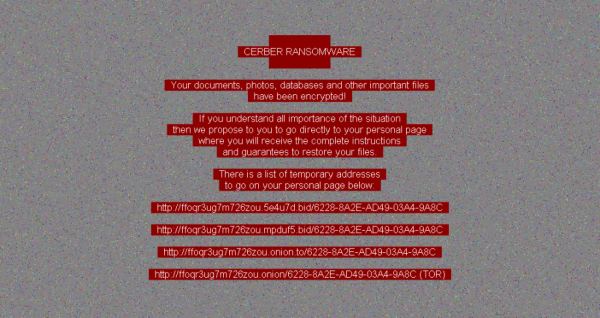IT security experts report the release of Cerber 6 containing a range of important modifications that separate this edition from any preceding version.

Detection of the new threat dates back to the end of March 2017. While relying chiefly on infecting via mass-mailing, the ransomware is much more flexible. Unlike other variants, it resorts to direct introduction, exploit kits on a routine basis. As regards spamming, the infection introduces new formats of the attachments that contain its malicious code. Meanwhile, old infection vectors remain in use.
Security researchers observe such a diversity of the infection vectors is due to the growing popularity of the Cerber ransomware. That is to say, the infection is available with minimum restrictions to anyone willing to propagate its copies on affiliate terms. Needless to say, the threat actors that disseminate the encryption plague are free in their choice. They select and implement a wide variety of propagation tactics. Some of them may enable the enthusiast and cyber police to trace back the invasion, but no further than to the distributor. The developers apply due precaution so that their communication both with victims and distributors does not disclose their identity.
Another novelty spotted in Cerber 6 ransom trojan is its using CryptoAPI as the main encryption cipher. This makes it similar to another recently reported encryption-for-ransom called Spora. Again, Cerber 6 needs to evolve in this component due to its enormous popularity. The fame attracts professional researchers that hopefully come up with a master decryptor for the old encryption algorithms.
To avoid detection, Cerber 6 plays a simple yet very efficient trick. The infection lingers. Once installed, it does not rush headlong into executing its encryption payload. That, in combination with other contra-security techniques such as abusing Windows firewall to block antivirus tools, makes the trojan virtually invulnerable.
To sum it up, Cerber 6 poses a brand new challenge. However, that shall not encourage its victims to pay the bitcoins demanded by the malware. A recap of the latest response to this malicious encryption attack is available below. It features user-friendly ransom-free recovery tips and tools that the users concerned are invited to try.
Automatic removal of Cerber 6 file virus
The benefits of using the automatic security suite to get rid of this infection are obvious: it scans the entire system and detects all potential fragments of the virus, so you are a few mouse clicks away from a complete fix.
- Download and install recommended malware security suite
- Select Start Computer Scan feature and wait until the utility comes up with the scan report. Proceed by clicking on the Fix Threats button, which will trigger a thorough removal process to address all the malware issues compromising your computer and your privacy.
Restore files locked by Cerber 6 virus
new Locky variant aka Cerber 6 ransomware represents a unique category of malicious software whose attack surface reaches beyond the operating system and its components, which is why removing the virus itself is a part of the fix only. As it has been mentioned, it encrypts one’s personal information, so the next phase of the overall remediation presupposes reinstating the files that will otherwise remain inaccessible.
-
Launch data recovery software
Similarly to the rest of its fellow-infections, Cerber 6 virus most likely follows an operational algorithm where it erases the original versions of the victim’s files and actually encrypts their copies. This peculiarity might make your day, because forensics-focused applications like Data Recovery Pro are capable of restoring the information that has been removed. As the virus further evolves, its modus operandi may be altered – in the meanwhile, go ahead and try this.
-
Take advantage of Volume Shadow Copy Service
This technique is based on using the native backup functionality that’s shipped with Windows operating system. Also referred to as Volume Snapshot Service (VSS), this feature makes regular backups of the user’s files and keeps their most recent versions as long as System Restore is on. Cerber 6 ransomware hasn’t been found to affect these copies therefore the restoration vector in question is strongly recommended. The two sub-sections below highlight the automatic and manual workflow.
- a) Use Shadow Explorer
Shadow Explorer is an applet that provides an easy way of retrieving previous versions of files and folders. Its pro’s include an intuitive interface where the computer’s entire file hierarchy is displayed within one window. Just pick the hard disk volume, select the object or directory to be restored, right-click on it and choose Export. Follow the app’s prompts to get the job done.

- b) Use file properties
Essentially, what the above-mentioned Shadow Explorer tool does is it automates the process that can otherwise be performed manually via the Properties dialog for individual files. This particular approach is more cumbrous but just as effective as its software-based counterpart, so you can proceed by right-clicking on a specific file, which has been encrypted by Cerber 6 virus, and selecting Properties in the context menu. The tab named Previous Versions is the next thing to click – it displays available versions of the file by date of the snapshot creation. Pick the latest copy and complete the retrieval by following the prompts.

-
Data backups work wonders
Ransomware like Cerber 6 virus isn’t nearly as almighty and destructive in case you run regular file backups to the cloud or external data media. The virus itself can be completely removed in a matter of minutes, and the distorted information can then be just as easily recovered from the backup. Luckily, this is a growing trend, so ransom Trojans are hopefully going to become less subversive in the near future.
Verify thoroughness of the removal
Having carried out the instructions above, add a finishing touch to the security procedure by running an additional computer scan to check for residual malware activity
